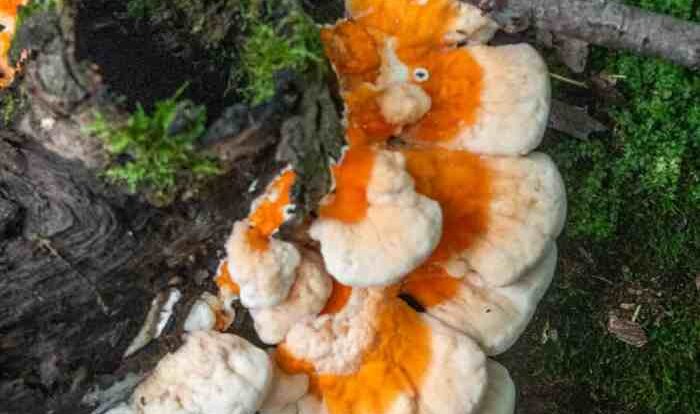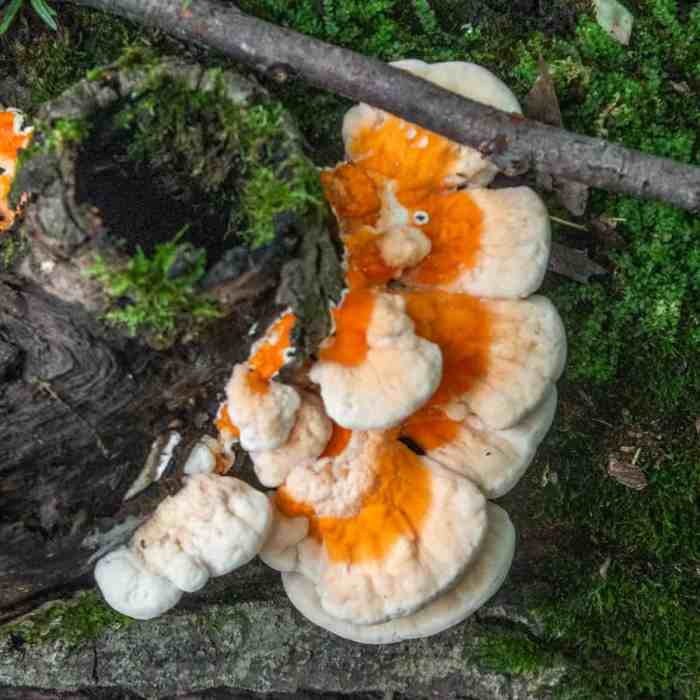
Embark on a culinary adventure with the chicken of the woods recipe! This wild mushroom offers a unique flavor and a host of health benefits, making it a must-try for foodies and health enthusiasts alike.
From foraging and identification to cooking techniques and creative culinary applications, we’ll explore everything you need to know about this fascinating fungus. So, get ready to elevate your meals with the delicious and nutritious chicken of the woods.
Culinary Inspirations

Chicken of the woods is a versatile mushroom that can be used in a variety of international cuisines. Its unique flavor and texture make it a popular ingredient in soups, stews, stir-fries, and even desserts.
Here is a table that provides an overview of some of the different cuisines that feature chicken of the woods, along with the unique flavors and cooking methods associated with each cuisine:
| Cuisine | Unique Flavors | Cooking Methods | Suggested Recipes |
|---|---|---|---|
| Chinese | Savory, umami | Stir-frying, braising, steaming | Chicken of the Woods Stir-Fry with Garlic and Ginger |
| Italian | Earthy, nutty | Sautéing, grilling, roasting | Chicken of the Woods with Roasted Vegetables |
| French | Rich, buttery | Sautéing, pan-frying, baking | Chicken of the Woods with Cream Sauce |
| Mexican | Spicy, smoky | Grilling, roasting, sautéing | Chicken of the Woods Tacos with Salsa Verde |
| Indian | Warm, aromatic | Currying, tandoori, grilling | Chicken of the Woods Curry with Basmati Rice |
Foraging and Identification

Chicken of the woods, scientifically known as Laetiporus sulphureus, is a widely distributed and recognizable mushroom. Foraging for this delicacy requires knowledge of its key characteristics and habitats. This guide will provide a comprehensive overview of how to safely forage and identify chicken of the woods.
Chicken of the woods is a polypore mushroom, meaning it has pores instead of gills on its underside. It typically forms large, shelf-like structures on the trunks or stumps of dead or dying hardwood trees, particularly oak, maple, and beech.
The mushroom is known for its vibrant orange to yellow coloration, which can vary depending on its age and exposure to sunlight.
Looking for a delectable vegetarian alternative? Check out this chicken of the woods recipe . Its unique texture and flavor will surely tantalize your taste buds.
Habitat and Distribution
Chicken of the woods is commonly found in deciduous forests throughout North America and Europe. It prefers warm and humid climates and often fruits during the late summer and fall months. When foraging, look for the mushroom’s distinctive shelf-like shape and bright coloration.
It is important to note that chicken of the woods can sometimes be mistaken for other similar-looking mushrooms, so proper identification is crucial.
For a hearty and flavorful meal, try out this chicken of the woods recipe . This versatile dish can be prepared in various ways, making it a great option for any occasion.
Key Characteristics
- Size:Large, shelf-like structures, typically ranging from 4 to 12 inches across.
- Color:Vibrant orange to yellow, fading to white or cream with age.
- Shape:Irregular, shelf-like with a wavy or lobed margin.
- Texture:Firm and meaty when young, becoming softer with age.
- Underside:Small, round pores instead of gills.
- Habitat:On the trunks or stumps of dead or dying hardwood trees, particularly oak, maple, and beech.
Identification Tips
To safely identify chicken of the woods, consider the following tips:
- Observe the color and shape:The mushroom’s bright orange to yellow coloration and shelf-like shape are distinctive.
- Check the underside:Look for small, round pores instead of gills.
- Note the habitat:Chicken of the woods is typically found on dead or dying hardwood trees.
- Avoid look-alikes:Be aware of similar-looking mushrooms, such as false chicken of the woods (Laetiporus gilbertsonii), which has a darker, reddish-orange color.
- Consult a field guide:Refer to a reputable field guide or consult with an experienced mushroom forager for confirmation.
Nutritional Value and Health Benefits

Chicken of the woods is a nutrient-rich mushroom with a meaty texture and a mild flavor. It is a good source of protein, fiber, and antioxidants.
The following table summarizes the nutritional content of 100 grams of cooked chicken of the woods:
| Nutrient | Amount |
|---|---|
| Calories | 119 |
| Protein | 12 grams |
| Fiber | 7 grams |
| Antioxidants | High |
Potential Health Benefits
Chicken of the woods has been shown to have several potential health benefits, including:
- Antioxidant activity:Chicken of the woods contains several antioxidants, which can help to protect cells from damage caused by free radicals.
- Anti-inflammatory activity:Chicken of the woods has been shown to have anti-inflammatory properties, which may be helpful in reducing inflammation throughout the body.
- Immune system support:Chicken of the woods contains several compounds that can help to support the immune system, including beta-glucans and polysaccharides.
Precautions and Contraindications
Chicken of the woods is generally considered safe to eat, but there are a few precautions and contraindications to keep in mind:
- Allergies:Some people may be allergic to chicken of the woods. If you experience any symptoms of an allergic reaction, such as hives, swelling, or difficulty breathing, stop eating chicken of the woods and seek medical attention.
- Digestive problems:Eating large amounts of chicken of the woods can cause digestive problems, such as gas, bloating, and diarrhea. If you experience any digestive problems after eating chicken of the woods, reduce the amount you eat or stop eating it altogether.
- Pregnancy and breastfeeding:There is not enough research on the safety of eating chicken of the woods during pregnancy or breastfeeding. If you are pregnant or breastfeeding, it is best to avoid eating chicken of the woods.
Cooking Techniques and Recipes

Chicken of the woods is a versatile mushroom that can be cooked in a variety of ways. It can be sautéed, grilled, roasted, or fried. The flavor of the mushroom is mild and nutty, making it a good choice for a variety of dishes.
Sautéing
- Clean the mushrooms by brushing off any dirt or debris.
- Cut the mushrooms into bite-sized pieces.
- Heat a large skillet over medium heat.
- Add the mushrooms to the skillet and cook until they are browned and tender, about 5-7 minutes.
- Season the mushrooms with salt and pepper to taste.
Grilling, Chicken of the woods recipe
- Clean the mushrooms by brushing off any dirt or debris.
- Cut the mushrooms into thick slices.
- Preheat a grill to medium-high heat.
- Grill the mushrooms for 5-7 minutes per side, or until they are cooked through.
- Season the mushrooms with salt and pepper to taste.
Roasting
- Clean the mushrooms by brushing off any dirt or debris.
- Cut the mushrooms into large chunks.
- Preheat an oven to 400 degrees Fahrenheit.
- Toss the mushrooms with olive oil, salt, and pepper.
- Spread the mushrooms on a baking sheet and roast for 20-25 minutes, or until they are tender and browned.
Frying
- Clean the mushrooms by brushing off any dirt or debris.
- Cut the mushrooms into bite-sized pieces.
- Heat a large skillet over medium heat.
- Add the mushrooms to the skillet and cook until they are browned and tender, about 5-7 minutes.
- Season the mushrooms with salt and pepper to taste.
Creative Culinary Applications

Chicken of the woods offers a versatile culinary canvas for creative chefs and home cooks alike. Its unique flavor and texture make it a delectable addition to various dishes, inspiring innovative ways to incorporate this woodland delicacy into both familiar and extraordinary culinary creations.
Meat Substitute
With its meaty texture, chicken of the woods serves as an excellent plant-based substitute for meat. It can be shredded, grilled, or roasted to create vegetarian or vegan versions of classic dishes like pulled pork, tacos, or stir-fries. The mushroom’s mild flavor allows it to absorb marinades and seasonings well, ensuring a flavorful and satisfying meatless meal.
Chicken of the woods, a versatile edible mushroom, offers a unique culinary experience. Whether you’re a seasoned chef or a novice in the kitchen, you’ll find a treasure trove of recipes to satisfy your cravings. From the tantalizing chicken of the woods recipe with its mouthwatering flavors to the delectable chicken of the woods recipe that will leave you longing for more, there’s something for every palate.
Flavoring Agent
The earthy, umami-rich flavor of chicken of the woods makes it an ideal ingredient for soups, stews, and sauces. It adds depth and complexity to dishes without overpowering other flavors. Dried and ground into a powder, it can be used as a flavorful seasoning for pasta, pizza, or grilled vegetables.
Decorative Element
The vibrant orange or yellow hues of chicken of the woods make it a visually striking addition to dishes. Its frilly texture adds a touch of elegance to salads, platters, and hors d’oeuvres. It can be sliced thinly and used as a garnish for soups, pizzas, or pasta dishes, creating a visually appealing and delicious presentation.
Unique Culinary Creations
Beyond traditional culinary applications, chicken of the woods has inspired chefs to create innovative and imaginative dishes that showcase its versatility. Some notable examples include:
- Chicken of the Woods Ceviche: Marinated in citrus juices and herbs, this dish transforms the mushroom into a refreshing and tangy seafood substitute.
- Chicken of the Woods Tempura: Deep-fried in a light batter, the mushroom’s tender interior and crispy exterior create a delightful appetizer or side dish.
- Chicken of the Woods Risotto: Arborio rice cooked in a creamy broth with sautéed chicken of the woods creates a rich and flavorful vegetarian risotto.
The culinary possibilities of chicken of the woods are limitless, encouraging experimentation and creativity in the kitchen. Its unique flavor, texture, and visual appeal make it a versatile ingredient that can elevate any dish to new heights of deliciousness and innovation.
Summary: Chicken Of The Woods Recipe
As we conclude our exploration of the chicken of the woods recipe, remember that this versatile mushroom is not just a culinary delight but also a source of nourishment and culinary inspiration. Whether you’re a seasoned forager or a home cook looking to expand your repertoire, the chicken of the woods is sure to impress with its unique flavor and endless possibilities.
So, embrace the wild side of cooking and incorporate this remarkable mushroom into your dishes. Happy foraging and happy cooking!
Question Bank
Is the chicken of the woods mushroom safe to eat?
Yes, the chicken of the woods mushroom is generally considered safe to eat when cooked properly. However, it’s essential to correctly identify the mushroom to avoid any confusion with similar-looking but potentially toxic species.
How do I identify the chicken of the woods mushroom?
The chicken of the woods mushroom has a distinctive bright orange to yellow color and a shelf-like shape. It typically grows on dead or decaying hardwood trees. Look for mushrooms with firm, non-slimy flesh and a mild, pleasant odor.
What are the health benefits of eating chicken of the woods mushrooms?
Chicken of the woods mushrooms are a good source of fiber, antioxidants, and vitamins. They have been linked to potential health benefits such as boosting the immune system, reducing inflammation, and supporting cardiovascular health.






